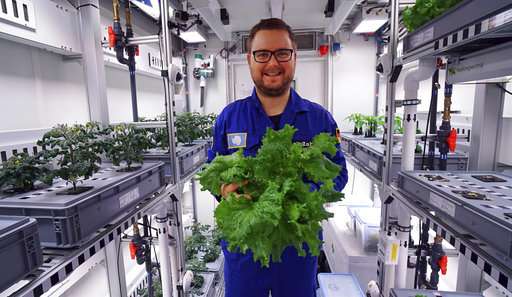by Larry
August, 2018Today a Fresh Antarctic Salad - Tomorrow a Tasty Martian Medley?When I first heard about this, I thought it another global warming story, how the coldest continent on Earth is now warm enough for growing fresh produce. That's not quite it. Instead, it turns out that scientists on Antarctica have been trying to see how space travelers of the not too far future might grow their own food while on the long trips to other planets and then subsist once arrived at distant worlds. Antarctica, vast, distant from more hospitable accommodations, and very cold, is considered a harsh enough environment to make growing the makings for a good salad a realistic challenge, given the longer-term aims. So, the first greenhouse established on the deep freeze continent, a so-called EDEN ISS project, arrived this past January. It has been set up at Germany's Neumayer Station III. An 8-country team of researchers are involved. 13 square meters of the greenhouse space are devoted to the plants of EDEN ISS. By comparison, the International Space Station has a garden of only one square meter. EDEN ISS grows a nice variety of edibles, including initially cucumbers, radishes, lettuce, Swiss chard, basil, chives, cilantro, and mint. Following those first harvests of about 8 pounds of veggies the month before, starting in May researchers were anticipating harvests of vegetables and even some fruit at a rate of roughly 10 pounds a week, 9 of which station researchers could then be adding to enhance their own regular vittles. Happily for residents of the Antarctica station, only a tenth of the produce is used for research, the balance available for consumption.
No soil is being used for the plants. After all, sufficient dirt is heavy and too expensive for transport even to Antarctica, let alone to other spheres. Nor are human fecal materials used. Instead, the plants grow in air and their roots receive a frequent mist of nutrients and water. A self-contained water system is employed. The surrounding area is also disinfected regularly to discourage microbe colonies. Occasional windstorms develop that prevent tending the greenhouse flora, keeping gardeners away for a day or two, but generally in season the plants are tended daily. Optimized arrangements of LEDs shine the necessary light. Carbon dioxide in the greenhouse is also maintained at a favorable level. Webcams allow for distant monitoring, both from Germany and the U.S. (University of Florida). If a tray begins to look a little peaked, the scientist gardeners can be alerted to check it out and assure it gets what is needed for continued healthy growing. Paul Zabel, the main gardener, needs to suit up for going outside, then change into another suit for looking after the plants in their special greenhouse building. Keeping tabs on how long such logistical factors take as well as the time needed for each of the plant care chores, maintenance of the environmental machinery, etc., will help determine the time and effort that may be required for such tasks in space or on the Moon or Mars. As evident from the picture, so far the results have been quite satisfactory. The German aerospace center (DLR) photo is undated but shows results obtained in the first harvests this past April at the EDEN ISS greenhouse project. Engineer Paul Zabel holds the makings of a salad he obtained via Antarctic farming. Sources: Antarctic Veggies: Practice For Growing Plants On Other Planets. Menaka Wilhelm in npr.org; April 18, 2018; Scientists Harvest First Vegetables in Antarctic Greenhouse. phys.org; April, 2018. |
